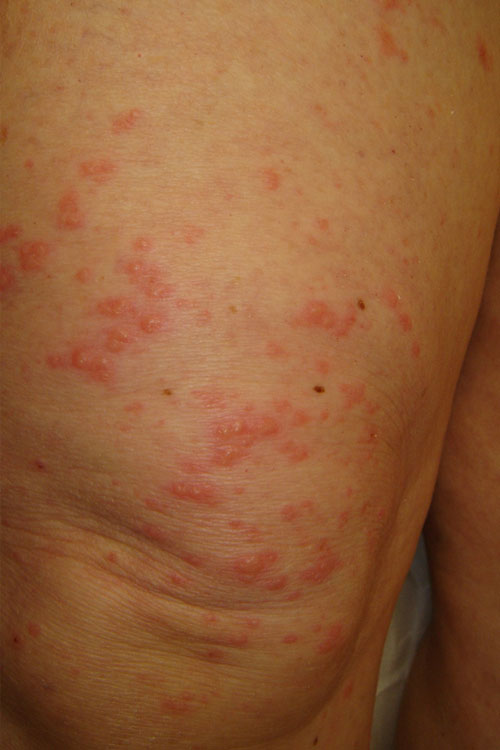Dermatitis herpetiformis
Dermatitis herpetiformis is a distinctive autoimmune blistering skin condition, with itchy vesicles and bullae on the elbows and knees and in the lumbosacral region. For photos of dermatitis herpetiformis, see here.
Gluten-sensitive enteropathy is always present; some patients with coeliac disease will develop dermatitis herpetiformisLebwohl, 2020Reunala, 2018Shields, 2020. More than 90% of patients with dermatitis herpetiformis will not have any enteropathic symptoms.
Dermatitis herpetiformis is overdiagnosed—before starting treatment, it is essential to confirm diagnosis with skin biopsy and direct immunofluorescence.


In most patients with dermatitis herpetiformis, a gluten-free diet is the treatment of choice. It resolves the rash and enteropathy, and improves quality of life. However, because dietary measures are slow to take effect, dapsone is used initially to control blistering lesions. Dapsone is usually not required long-term.
Dapsone therapy is usually prescribed under dermatologist supervision because careful monitoring is required (particularly for adverse effects such as haemolysis and agranulocytosis). Before starting dapsone therapy, exclude glucose-6-phosphate dehydrogenase deficiency and order a baseline full blood count. Regular full blood counts are required while on dapsone therapy; monitoring frequency is determined by the specialist (eg weekly during the initial titration of dapsone dose, then every 2 weeks for the first 3 months, then every 3 months afterPiette, 2012). Also refer to product information for dapsone monitoring information. Do not use dapsone in patients:
- with immediate hypersensitivity to sulfonamides
- who have previously had a severe skin reaction to sulfonamides (eg drug rash with eosinophilia and systemic symptoms [DRESS], Stevens–Johnson syndrome, toxic epidermal necrolysis).
In combination with a gluten-free diet, initial treatment of dermatitis herpetiformis in adults isSalmi, 2019:
dapsone 25 mg orally, once daily, increasing cautiously to a maximum of 100 mg orally, daily, if required. Use the minimum effective dose to reduce the risk of adverse effects. dapsone dapsone dapsone
Once the gluten-free diet takes effect, gradually reduce the dose of dapsone (doses as low as 25 mg daily may be sufficient), with the goal of stopping the drug if possible.
Alternative options to dapsone used by dermatologists include sulfasalazine (not in patients with immediate hypersensitivity to sulfonamides) and colchicine.
